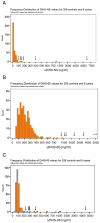Newborn screening and diagnosis of mucopolysaccharidoses
- PMID: 23860310
- PMCID: PMC4047214
- DOI: 10.1016/j.ymgme.2013.06.007
Newborn screening and diagnosis of mucopolysaccharidoses
Abstract
Mucopolysaccharidoses (MPS) are caused by deficiency of lysosomal enzyme activities needed to degrade glycosaminoglycans (GAGs), which are long unbranched polysaccharides consisting of repeating disaccharides. GAGs include: chondroitin sulfate (CS), dermatan sulfate (DS), heparan sulfate (HS), keratan sulfate (KS), and hyaluronan. Their catabolism may be blocked singly or in combination depending on the specific enzyme deficiency. There are 11 known enzyme deficiencies, resulting in seven distinct forms of MPS with a collective incidence of higher than 1 in 25,000 live births. Accumulation of undegraded metabolites in lysosomes gives rise to distinct clinical syndromes. Generally, the clinical conditions progress if untreated, leading to developmental delay, systemic skeletal deformities, and early death. MPS disorders are potentially treatable with enzyme replacement therapy or hematopoietic stem cell transplantation. For maximum benefit of available therapies, early detection and intervention are critical. We recently developed a novel high-throughput multiplex method to assay DS, HS, and KS simultaneously in blood samples by using high performance liquid chromatography/tandem mass spectrometry for MPS. The overall performance metrics of HS and DS values on MPS I, II, and VII patients vs. healthy controls at newborns were as follows using a given set of cut-off values: sensitivity, 100%; specificity, 98.5-99.4%; positive predictive value, 54.5-75%; false positive rate, 0.62-1.54%; and false negative rate, 0%. These findings show that the combined measurements of these three GAGs are sensitive and specific for detecting all types of MPS with acceptable false negative/positive rates. In addition, this method will also be used for monitoring therapeutic efficacy. We review the history of GAG assay and application to diagnosis for MPS.
Keywords: CF; CNS; CPC; CS; DBS; DMB; DS; ERT; ESI-MS/MS; GAG; GALNS; GUS; Glycosaminoglycans; HPLC; HS; HSCT; KS; LC–MS/MS; MPS; Monitoring; Mucopolysaccharidoses; N-acetylgalactosamine-6-sulfate sulfatase; NBS; Newborn screening; SRT; Tandem mass spectrometry; central nervous system; cetylpyridinium chloride; chondroitin sulfate; cystic fibrosis; dermatan sulfate; dimethylmethylene blue; dried blood spot; electrospray ionization tandem mass spectrometry; enzyme replacement therapy; glycosaminoglycans; hematopoietic stem cell transplantation; heparan sulfate; high performance liquid chromatography; high performance liquid chromatography tandem mass spectrometry; keratan sulfate; mucopolysaccharidoses; newborn screening; substrate reduction therapy; β-glucuronidase.
Copyright © 2013 Elsevier Inc. All rights reserved.
Figures









References
-
- Applegarth DA, Toone JR, Lowry RB. Incidence of inborn errors of metabolism in British Columbia, 1969–1996. Pediatrics. 2000;105:e10. - PubMed
-
- Baehner F, Schmiedeskamp C, Krummenauer F, Miebach E, Bajbouj M, Whybra C, Kohlschütter A, Kampmann C, Beck M. Cumulative incidence rates of the mucopolysaccharidoses in Germany. J Inherit Metab Dis. 2005;28:1011–1017. - PubMed
-
- Meikle PJ, Hopwood JJ, Clague AE, Carey WF. Prevalence of lysosomal storage disorders. JAMA. 1999;281:249–254. - PubMed
-
- Nelson J. Incidence of the mucopolysaccharidoses in Northern Ireland. Hum Genet. 1997;101:355–258. - PubMed
Publication types
MeSH terms
Substances
Grants and funding
LinkOut - more resources
Full Text Sources
Other Literature Sources
Medical
Research Materials
Miscellaneous

